Eurocom P5 Pro / Clevo P750ZM Review: True DTR
by Jarred Walton on March 10, 2015 10:00 AM ESTClevo P750ZM LCD: 4K IGZO
HiDPI panels are becoming increasingly commonplace, and while there are still compromises involved (e.g. at least a few games that we tested didn’t like having scaling at something other than 100%), it’s definitely more of a future-looking decision. I’m not sure anyone other than an eagle would really use the Windows desktop at 4K with 100% scaling on a 15.6” display, but that option is always there. Personally, 2560x1440 would have been more reasonable, and you can even add that option via the NVIDIA control panel (which I did), but IGZO does generally mean you get one of the best quality panels currently available. Let’s see how it looks.
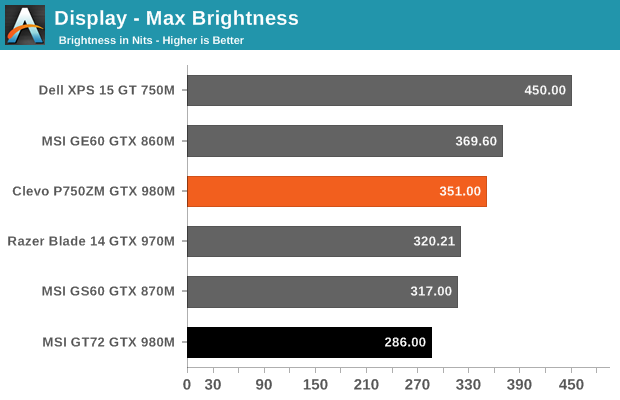
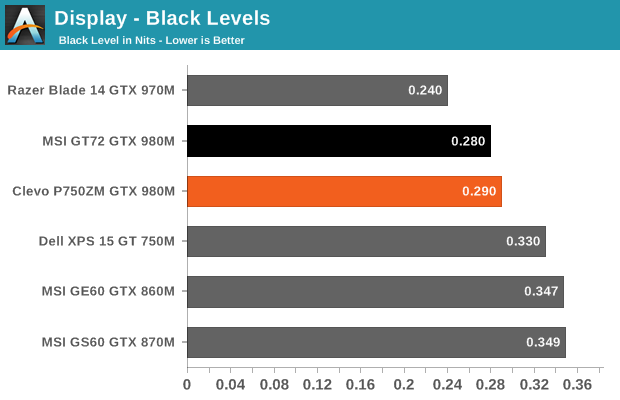
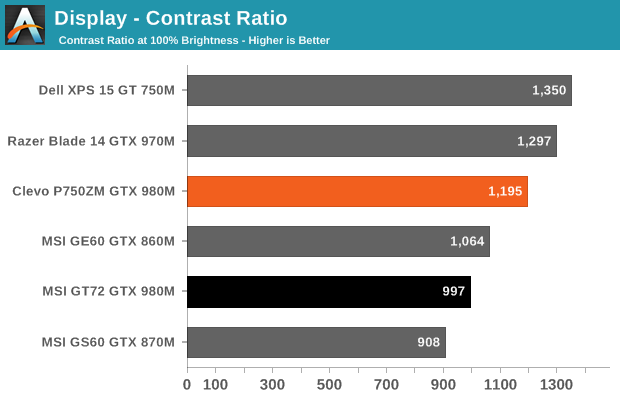
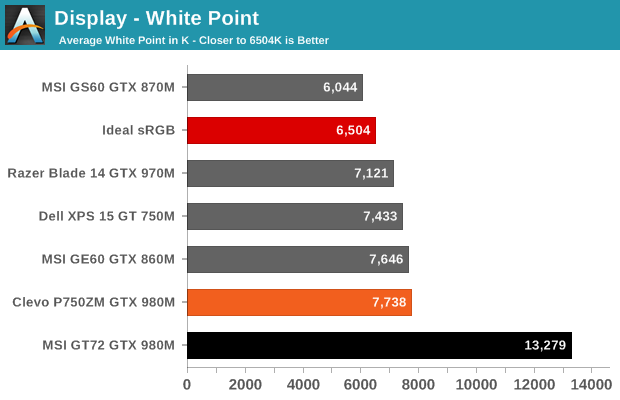
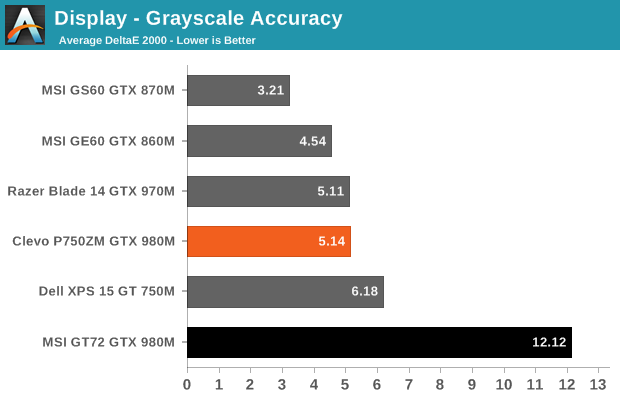
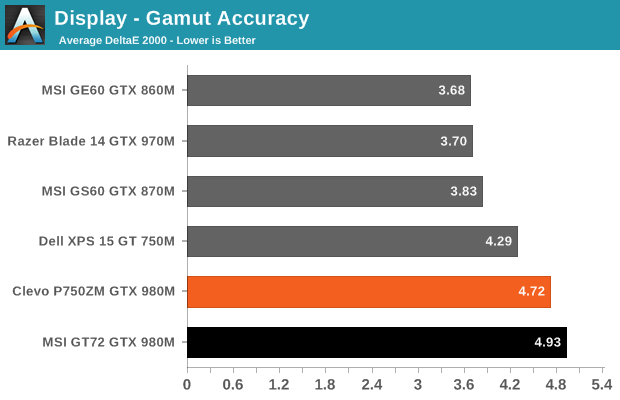
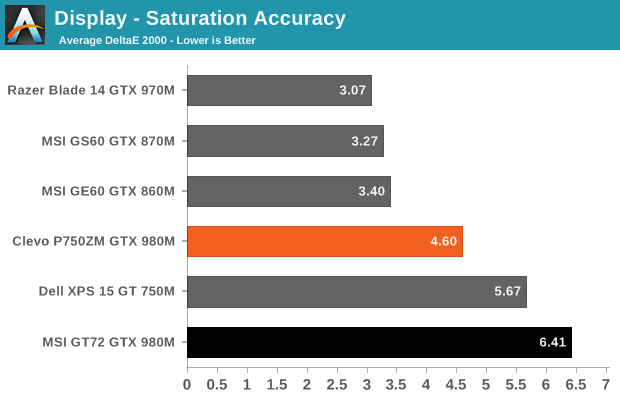
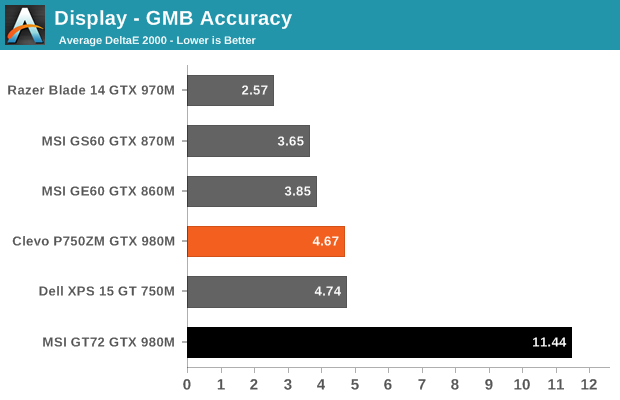
Uncalibrated, the maximum white level of 350cd/m2 is good if not chart topping. The black level of 0.29 nits at max brightness is also great, leading to a roughly 1200:1 contrast ratio. However, we noticed at lower brightness settings that the contrast trails off – we measured closer to 1000:1 at 200 nits for example. The average CCT isn’t perfect but it’s not terrible. Still, looking at the various delta E results shows the display could benefit from calibration.
Post-calibration the LCD is nearly perfect in most colors, with a few that still fall above 3.0 dE. Most of these problem colors are orange or blue hues, but there are plenty of close colors that are well below 3.0 as well. The greyscale Delta E is essentially perfect, as are the primary colors, but the saturations and colorchecker results are a bit higher. In short, it’s a great display overall and better than most other laptop panels…but it’s still not perfect.


_thumb.jpg)
_thumb.jpg)
_thumb.jpg)
_thumb.jpg)
_thumb.jpg)
_thumb.jpg)




















74 Comments
View All Comments
JarredWalton - Tuesday, March 10, 2015 - link
Correct I believe: AFAIK, NVIDIA requires a mobile chipset to enable Optimus. I don't think there's any technical reason why they couldn't do it on a desktop chipset, but then even if it was supported Clevo likely wouldn't have enabled this as it's a high-end notebook.boeush - Tuesday, March 10, 2015 - link
I must be going crazy... but why is it nobody asks or comments about availability of screens with a non-16x9 aspect ratio?? A machine claiming to be DESKTOP REPLACEMENT should be usable for more then movie watching. How the hell is one supposed to work on documents or do any serious coding where the VERTICAL real live state is far more valuable than horizontal? Where are 2560x1600 matte 17-18" screens??? Is nobody making them? Is there no demand - am I the only lunatic who dreams of them year after year as if they were some unachievable sci-fi fantasy?boeush - Tuesday, March 10, 2015 - link
*sigh* pardon the stupid typos brought to you courtesy of auto-incorrect on my smartphone... You get the gist though, I hope...chlamchowder - Tuesday, March 10, 2015 - link
The Surface Pro 3 has a 3:2 screen.Yeah, I don't get what's up with the "shortscreen" format. Maybe people just really like scrolling. I miss my first laptop, which had a 4:3 screen.
boeush - Tuesday, March 10, 2015 - link
Unfortunately, Surface Pro 3 isn't what I'd call "desktop replacement". When it comes to the latter, for me at least, anything less than 17" is a joke. On DTR machines I expect a large high-res screen, and a full-size keyboard (not a reused one originally designed for a 15.6" form factor.) Man, I'd KILL for a 4:3 screen on a DTR laptop. But at least 16:10 is the minimum for me; that's where I draw the line. It's why I still haven't upgraded from my ancient DELL M6400: all the newer machines (even ones styled as "mobile workstations"!!) are hopelessly mired in the 16:9 nightmare...Notmyusualid - Wednesday, March 11, 2015 - link
^ Kind of sums up the situation for me too.kgh00007 - Tuesday, March 10, 2015 - link
Nice review! Is there any chance you are going to ger in the 2015 Alienware 15 for review?D2ultima - Wednesday, March 11, 2015 - link
Glad to see a really nice review of one of these machines that reviews it for the capacity it's designed for, and not just complain about its size or aesthetics. Thanks very much for this Anandtech *gives thumbs up*mrcaffeinex - Wednesday, March 11, 2015 - link
Since they squeezed a desktop i7 (88W TDP) and a dedicated mobile GPU into one of these things, I am curious if it would be possible for someone to squeeze something like the AMD A10-7800 APU (65W TDP) into a notebook chassis. I would think it could be done, and at a price point that would make it appealing too. Any thoughts?JarredWalton - Wednesday, March 11, 2015 - link
It's possible to do it, sure, but the question is whether it's actually worth doing? If you just want a reasonably fast processor, Intel has plenty of mobile parts that can likely match the A10 desktop parts for performance while using less power.In single-threaded performance, any Core i5 mobile part can beat the A10-7850K. For multi-threaded workloads, the A10-7850K might be a bit faster than a Core i5-4330m, but if so not by much. So you have a higher power APU that will require better cooling and end up delivering less performance. Sure, Graphics is faster than the Intel GPU, but that's not saying much.